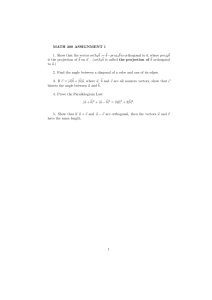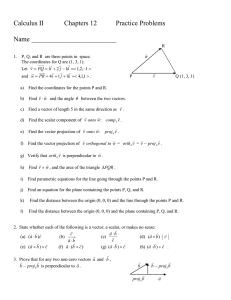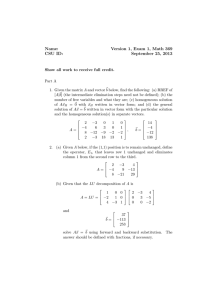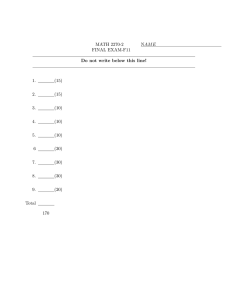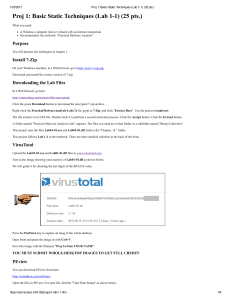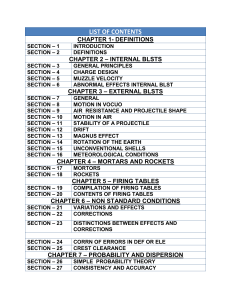Calculus II: Vectors Worksheet - Practice Problems
advertisement
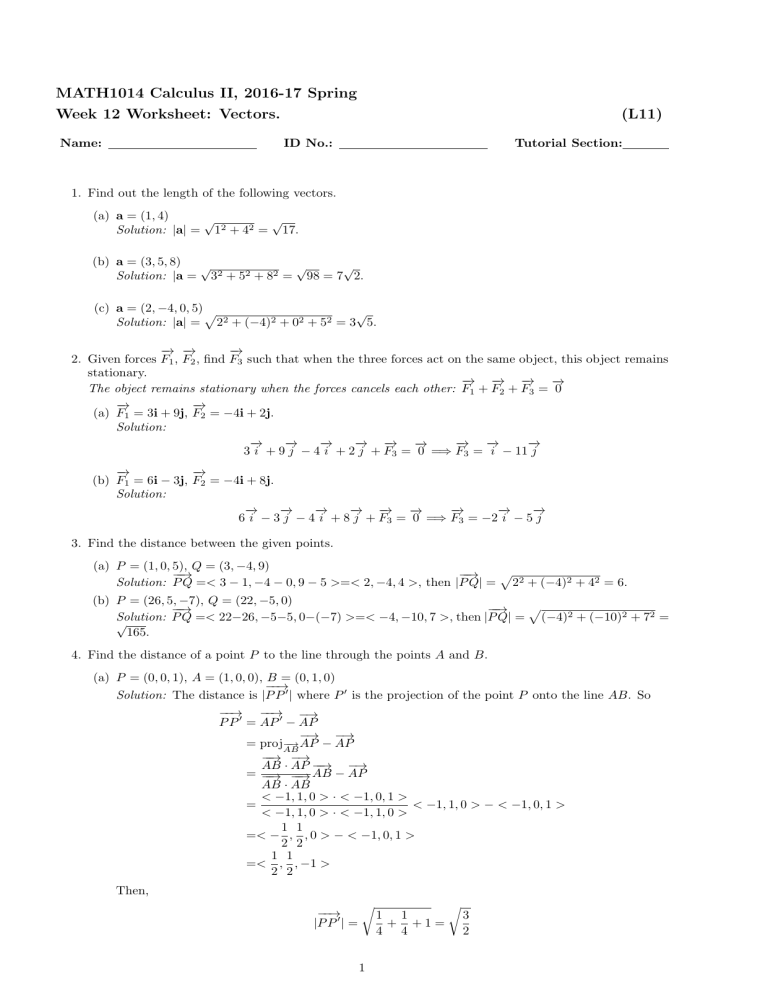
MATH1014 Calculus II, 2016-17 Spring Week 12 Worksheet: Vectors. Name: (L11) ID No.: Tutorial Section: 1. Find out the length of the following vectors. (a) a = (1, 4) √ √ Solution: |a| = 12 + 42 = 17. (b) a = (3, 5, 8) √ √ √ Solution: |a = 32 + 52 + 82 = 98 = 7 2. (c) a = (2, −4, 0, 5) √ √ Solution: |a| = 22 + (−4)2 + 02 + 52 = 3 5. − → − → − → 2. Given forces F1 , F2 , find F3 such that when the three forces act on the same object, this object remains stationary. − → − → − → → − The object remains stationary when the forces cancels each other: F1 + F2 + F3 = 0 − → − → (a) F1 = 3i + 9j, F2 = −4i + 2j. Solution: → → − → → → − → − − → − → − − → − − 3 i + 9 j − 4 i + 2 j + F3 = 0 =⇒ F3 = i − 11 j − → − → (b) F1 = 6i − 3j, F2 = −4i + 8j. Solution: → − − → − → − → − → − → − − → − → → 6 i − 3 j − 4 i + 8 j + F3 = 0 =⇒ F3 = −2 i − 5 j 3. Find the distance between the given points. (a) P = (1, 0, 5), Q = (3, −4, 9) √ −−→ −−→ Solution: P Q =< 3 − 1, −4 − 0, 9 − 5 >=< 2, −4, 4 >, then |P Q| = 22 + (−4)2 + 42 = 6. (b) P = (26, 5, −7), Q = (22, −5, 0) √ −−→ −−→ Solution: P Q =< 22−26, −5−5, 0−(−7) >=< −4, −10, 7 >, then |P Q| = (−4)2 + (−10)2 + 72 = √ 165. 4. Find the distance of a point P to the line through the points A and B. (a) P = (0, 0, 1), A = (1, 0, 0), B = (0, 1, 0) −−→ Solution: The distance is |P P ′ | where P ′ is the projection of the point P onto the line AB. So −−→′ −−→′ −→ P P = AP − AP −→ −→ − → AP − AP = proj− AB −−→ −→ AB · AP −−→ −→ = −−→ −−→ AB − AP AB · AB < −1, 1, 0 > · < −1, 0, 1 > = < −1, 1, 0 > − < −1, 0, 1 > < −1, 1, 0 > · < −1, 1, 0 > 1 1 =< − , , 0 > − < −1, 0, 1 > 2 2 1 1 =< , , −1 > 2 2 Then, −−→ |P P ′ | = √ 1 1 1 + +1= 4 4 √ 3 2 (b) P = (1, 0, 1), A = (1, 1, 0), B = (0, 1, 1) −−→ Solution: The distance is |P P ′ | where P ′ is the projection of the point P onto the line AB. So −−→′ −−→′ −→ P P = AP − AP −→ −→ − → AP − AP = proj− AB −−→ −→ AB · AP −−→ −→ = −−→ −−→ AB − AP AB · AB < −1, 0, 1 > · < 0, −1, 1 > = < −1, 0, 1 > − < 0, −1, 1 > < −1, 0, 1 > · < −1, 0, 1 > 1 1 =< − , 0, > − < 0, −1, 1 > 2 2 1 1 =< − , 1, − > 2 2 Then, −−→ |P P ′ | = √ 1 1 +1+ = 4 4 √ 3 2 5. Find the projection of the vector u onto v – that is projv u. And then find out the angles between the two vectors. (a) u = (1, 0, 5), v = (0, 10, 3) Solution: − → − 15 75 v ·→ u− < 0, 10, 3 > · < 1, 0, 5 > → − → − proj→ < 1, 0, 5 >=< , 0, > v = v u = − → → − < 1, 0, 5 > · < 1, 0, 5 > 26 26 v · v (b) u = (−1, 1, 5), v = (−1, 2, 3) Solution: → − → 9 18 27 v ·− u− < −1, 1, 5 > · < −1, 2, 3 > − → → − proj→ < −1, 2, 3 >=< − , , > v = v u = → − − < −1, 2, 3 > · < −1, 2, 3 > 7 7 7 v ·→ v 6. Calculate the cross product of the vectors given in the previous question. (a) u = (1, 0, 5), v = (0, 10, 3) Solution: − → → u ×− v = → − → − → − i j k 1 0 5 0 10 3 − → − → − → = −50 i − 3 j + 10 k (b) u = (−1, 1, 5), v = (−1, 2, 3) Solution: − → → u ×− v = − − → − → → i j k −1 1 5 −1 2 3 2 → − → − → − = −7 i − 2 j − k
